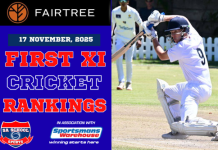Cricket Rankings Formula
The formula relies on several key factors, including the strength of opposition, margin of victory, margin of loss, actual runs/wickets scored on the field , home and away status, actual result (W/L/D) and others. Each of these factors garners a team a prescribed amount of bonus points which is accumulated and divided by the matches played to render an “average bonus points” which is ultimately ranking a team.
As you may appreciate when these factors are used in the equation no two teams will be rewarded the same number of points even if the result (W/L/D) is the same. For example: If TEAM A beats TEAM B by 100 runs and TEAM C beats TEAM B 50 runs, the result is the same but can we really say that the result is identical and should be valued the same? Not at all, TEAM A clearly, based on scoring more runs and winning by a greater margin, deserves more reward for their effort. What about TEAM B, should they not get rewarded for losing by fewer runs when they played TEAM C? Of course, they should. However, what if TEAM C beat TEAM B away from home but TEAM A’s victory was at home? Should TEAM C get an extra reward for their efforts? Yes of course they should. That is just one variable of many that the rankings formula factors in. Multiply that example by the over 300 teams in the system and you may appreciate that all the results from all the teams and all the factors for all the teams will have a bearing on the final rankings table. As any statistician will tell you the more factors that are used the closer one gets to a truer picture.
The formula however does not consider teams who are ‘unlucky’, or have injured players, or poor umpiring decisions etc. It just looks at the numbers. The rankings formula has zero emotion.
Average Bonus Points Column
With regard to the ‘’average bonus points’’ column which is ultimately ranking a team it must be appreciated that these numbers are always fluid and will go up or down even if a team wins a match because it is an average and reliant on different variables that are being entered depending on the different factors that will vary from match to match even if a team wins every match.
Example: Johnny records the following maths marks for his tests:
70%
75%
82%
71%
His average mark will be = 74.5 %
When Johnny does his next test which are a little more difficult, he once against passes the test (wins the match) but this time he gets 64% for his test. A pass. Will his average go up or down now? Obviously even though he passed the test well his average went down to 72.4%. Johnny would therefore not really be taken seriously if he complained that his average went down even though he passed the test (won the match).
As mentioned earlier each factor in the rankings equation: Strength of opposition, margin of victory, margin of loss, actual points scored on the field, actual results (W/L/D) , home and away status and others garners a team a prescribed amount of bonus points. These bonus points will vary from match to match as all these factors will be different from match to match. These bonus points are tallied and divided by matches played to render an average.
Other factors that might cause a shock!
- Sometimes outstanding results from week’s earlier have finally made it to us and have been included. Team A may well have won a match this past weekend but a result that had not been captured many weeks earlier has now been entered, causing questions as to why Team A has ‘gone down’ when they just won.
- Time/Declaration matches. Drawn results need to be agreed upon by both teams. Generally although technically a match ends in a ‘draw’ a win can be attribute to a team on the basis of 1st innings scores.
- Matches against 2nd or “B” teams or clubs are not recorded. Only 1st XI vs 1st XI or A team vs A team are used. RPC and HUB matches are recorded.
- Unless agreed upon by both teams, pre-season matches are included. This helps to get a cross-provincial understanding of the strength of the various teams.
- Tour matches are also included.
- At times due to imperfection we have entered incorrect data or been provided with an incorrect result. We encourage coaches and schools to check with us to see if this is the case.
Best ways to improve ranking standing?
Although not always possible some of the best ways to improve are the following:
- Play against as strong an opposition as possible. At times even a loss against a stronger opposition will garner a team more ‘bonus points’ than a win against a weaker team.
- Win by big margins. Especially against weaker opposition, the winning margin must be as large as possible. The formula is already not going to ‘grade’ your win over a weaker team highly, so its important to make up ground by winning big. Many teams take that kind of match less seriously and are happy just to win by whatever margin or understandably field an ‘emerging’ team that just gets over the line. However as stated earlier the formula just looks at the numbers and will record a ‘close win over weak opposition’ which will hurt on the rankings. This may not be totally unavoidable but often a reason for a winning team feeling aggrieved.
- If you are not fielding an official 1st XI of A team, inform the opposition before the match that they are not playing against your official 1st XI or A team. This will ensure the result does not count. Otherwise invariably the winning team is going to claim the result as they were under the impression it was 1st XI vs 1st
Hopes that helps understand some of the ‘anomolies’ that might seem to be odd at first glance. Having published the rankings for the past 17 years we have found that most anomalies are ironed out as the season progresses and more matches are played.





